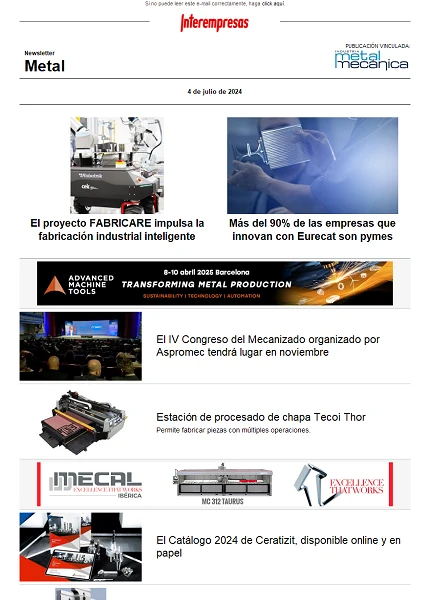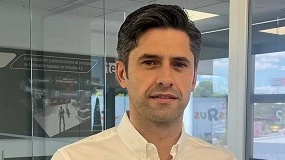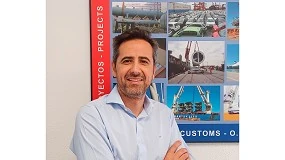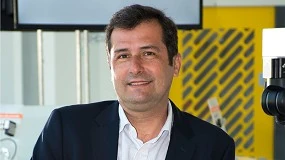This news article was originally written in Spanish. It has been automatically translated for your convenience. Reasonable efforts have been made to provide an accurate translation, however, no automated translation is perfect nor is it intended to replace a human translator. The original article in Spanish can be viewed at
Las levas inteligentesThe existence of powerful mathematical programs such as the Matlab allow for approximations to the curve in polynomial form with high accuracy
Smart cams
Luís Miguel Sainz, Technical Director of B & R Spain10/06/2008
June 10, 2008
Change from mechanical to electronic cam cams has been a giant step in the concept of industrial machinery and the flexibility offered in the industrial world. Acoposmulti of
B & R and Acopos servo go much further by providing a new concept in design and treatment of the electronic cam. The ability to design only the most critical part of the cam and unprecedented flexibility are some of the most outstanding possibilities offered and whose analysis is the goal of this article.
Initially, the introduction of electronic cams in a production line allowed a change of product or treatment with a single button. The advance was in itself very significant, as it allowed save much time avoiding heavy mechanical processes that almost always lead to premature wear of the material. With electronic cams, improving performance in the production which lasted the life of the machine thanks to its flexibility.
On the other hand it requires a computer system that allows the user to design electronic cams which will need. At the same time it was necessary in most cases to think carefully about cams to load, since the programmer needed each time that it wanted to introduce some modification.
Subsequently, solutions such as the 'teaching' or point clouds have provided more or less good approximations that did not require the presence of the programmer. Today the existence of as powerful as the Matlab mathematical programs, allow to obtain approximations to the curve in polynomial form with great precision. In the case of B & R one can define a single cam with up to 64 sections of consecutive sixth degree polynomials; Thus is done to minimize the error when it comes to the movement that has been designed in a simple way. In this case already we do not need the intervention of the programmer, because that would be sufficient to introduce the terms of polynomials through a user's screen.
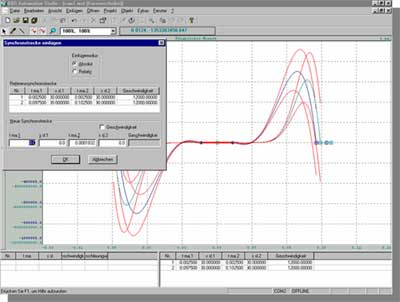
A well designed camshaft editor can save development time and at the same time in the right environment to offer lots of possibilities in its use.
Cam on the fly
Often it is not even necessary to design the cam as a whole. Is often the case that a slave axis must have a relationship of coupling with a master during a precise distance (for example: at the Court on the fly), and accelerating or decelerating shortly afterwards to return to dock again in a manner as smooth as possible. In these cases the creation of a fixed camshaft proves ineffective because to us it would force them to follow a fixed trajectory unnecessarily.
B & r solution in these cases is very effective because it applies the principle: "Let the servodrive decides the movement in that part of the cam where it is not fixed". In other words, the Acopos or Acoposmulti is responsible for uniting the sections in which we define a behavior-fixed position and/or speed (CAM) with curves that will optimize the movement to make this as smooth as possible. In this way it optimizes the time of the path, the current consumption and extends the life of the engine.
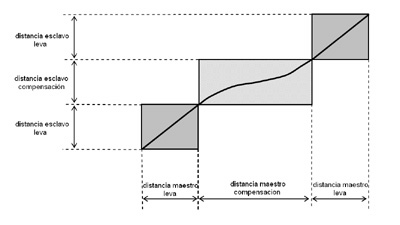
Algorithm of compensation leave freely choose the movement to the axis during the section in which does not need a specific behavior for the axis.Only requires defining compensation distances and shaft fits the camshaft in the points limit.
The advantages that the servodrive decides a part of the path not only confined to the dynamics of the movement. Provided that we make a correction, we will make it by reducing or increasing the area where the own servodrive decides the path. Thus the correction is almost always imperceptible and equally smooth. Especially the movement to corrections of mark much distance or a very rapid response to an unusual situation, will have a better dynamic if we leave the servodrive trace the trajectory if same. In addition the system allows to set minimum distances to the axes not performed trajectories with not allowed or too violent movements.
However in the most demanding applications, not only requires great flexibility in the creation of the camshaft, but also in its use. A clear example is the decision-making on the cam to go at any given time. For example, a cut to the very critical flight time would be much more effective if decisions on the exact time of beginning of the movement is carried out by the own servodrive; Thus it is not necessary to wait for the automaton to send the boot order via a field bus. This possibility also offer the Acopos and Acoposmulti, servo, based on some predetermined events, making decisions in only 400 µs. This listing improves the accuracy and speed in responding to external events. The sooner you react, the lower the accelerations necessary to adapt the movement; so also this improvement allows us to improve the dynamics and less abrupt movements.
Virtual axes and axis additives
So far we have seen that the flexibility to create, manage and initiate cams gives us significant advantages when it comes to a coupling between two axes. There are many cases in which a counterpart relationship requires other virtual axes and additional links to perform master changes, corrections, adjustments, and ultimately provide greater precision and flexibility
The contribution of the Acopos and Acoposmulti servo returns to be very interesting, because they have links in which the teacher can change in real time. I.e. that the servodrive can make decisions in real time (as we saw earlier) where also involved cam can be seen with different teachers. This fact allows us to increase very significantly the possibilities for solutions to complex problems, as we can fit us as slave to any of the virtual axes of any other servodrive present in the network.
A step further in the flexibility gives it us the use of slave axes additives and additive master axes. Its use is another way to make corrections and adjust the position of the master and the slave. The scheme of the behavior of the additive additive and master slave axes is that seen in the graphic attached. Once again, any virtual axis or accessible external axis in the network can serve as master, master axis additive or additive slave.
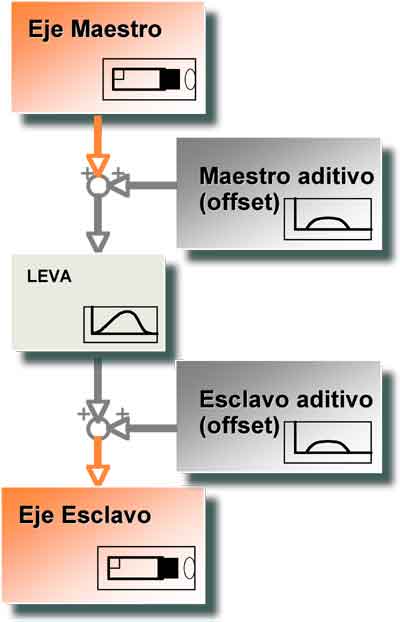
The flexibility that provide additive axes is useful when it comes to solve complex applications of 'motion'.
Calculating with the axes
Once again, Acopos and Acoposmulti servo arrive even further to provide greater flexibility in the couplings between axles. Not only it allows the use of additives slave axes and axis master additives, but that there are also various functional blocks within these servo that allow us to perform operations before associating them as a master axis or as additive axis:
-Arithmetic operations
-Multiplexed
-Tweens
-Filtering
-Limitation
-Delays
These operations conducts the own servodrive internally in a cycle time of 400 µs, which is the same cycle time to the position of the servo loop. In this way operations are executed while is the reading of the positions of encoder and the generation of new slogans.
Much more than a counterpart relationship
Apparently up to now one could argue that the cam editor serves to define a relationship between parameters, one entrance and one exit. Normally this relationship will be used to define the behavior of a slave with regard to the position of a master axis.
However in the servo Acopos and Acoposmulti will use this editor to define any type of relationship that defines us the inner workings. Here are some examples:
-Motto of couple in function of the speed or time
-Motto of speed depending on width of coil
-Limitation of speed depending on the temperature of the engine
-Gain loop speed and position based on the own speed
In these cases the editor of camshaft is not more than a simple way of defining the relationship between two parameters, which can be subsequently assigned to torque, speed, temperature, time, the PID controller parameters or simply the position. Thus the link between master and slave is not only one of many utilities allowing us the use of the editor of camshaft. Or rather, it's one of the many utilities that you can associate with a clever use of own cam editor, whose only limit, now yes, give us it needs and our own creativity.

In this example the cam editor helps us define the limitation of torque depending on the speed of a shaft. Properly interpret this information only is within reach of the most innovative market servo.
Ultimately, our traditional concept of cam as fixed relationship counterpart is largely overwhelmed by the amount of possibilities and utilities that are associated today and which we have tried to describe. However, increased flexibility which requires the industrial machinery leads us to think that it will continue to be an almost indispensable tool for defining behaviors to measure of the engines.
Related Companies or Entities
B & R Industrial Automation Ibérica, S.L.U.


























